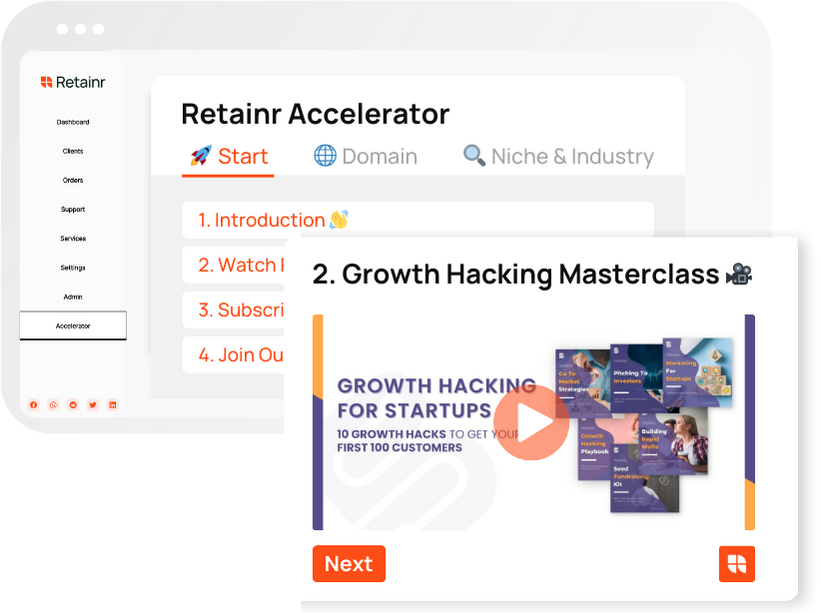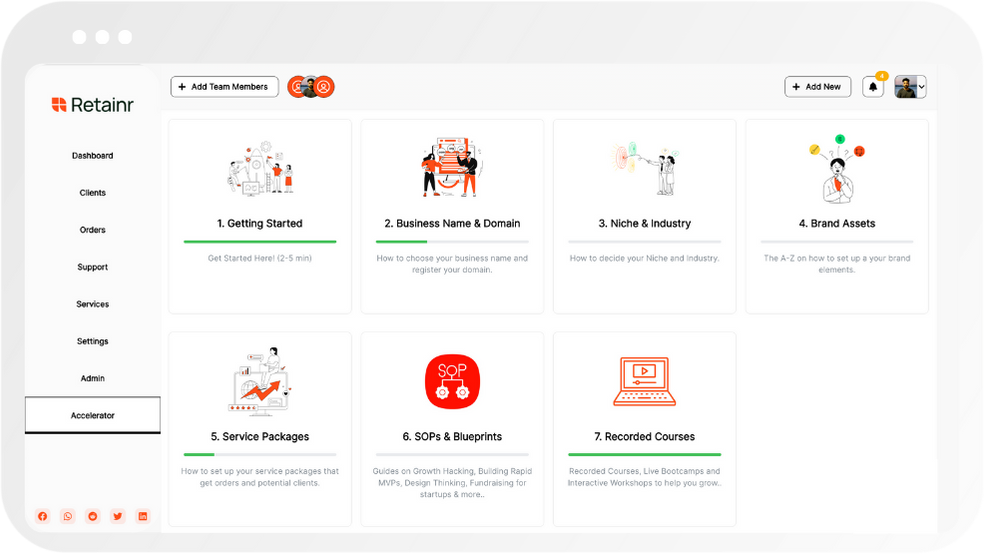
The 9 Most Common Target Industries and How to Identify Yours
Build with Retainr
Sell your products and services, manage clients, orders, payments, automate your client onboarding and management with your own branded web application.
Get Started1. What are the nine most common target industries?
The Nine Most Common Target Industries
The business landscape is vast, divided into various industrial sectors each with unique characteristics and demands. While dozens of industries exist, a number of them serve as key targets for a majority of businesses given their economic influence and extensive consumer base. Among the most prevalent include:
- Retail
- Healthcare
- Information Technology
- Financial Services
- Education
- Manufacturing
- Automotive
- Construction
- Entertainment and Media
Identifying Your Target Industry
In determining your target industry, several factors come into play. These can range from your business’s nature and purpose to the potential size and demographic of your customer base. More specifically, you can seek pointers from:
| Factor | Explanation |
|---|---|
| Business Type | What you offer—products or services—can point to a suitable target industry. For instance, a tech startup is likely to target the tech industry. |
| Customer Demographics | This entails understanding the age, location, income level, and hobbies of your customers. |
| Market Trends | These determine the existing demand and supply in various sectors and can guide where your offerings may find the most traction. |
| Competitor Analysis | Studying the industries where similar businesses flourish can reveal potential opportunities and threats within these sectors. |
Understanding your target industry is a crucial step in strategizing business growth. By identifying and learning about your sector of choice, you can better tailor your marketing efforts and product developments for the most profitable outcomes.
2. How can I identify which target industry my product falls into?
Identifying Your Target Industry
The task of identifying which target industry your product falls into requires a broad understanding of both your product and the market landscape. It can be achieved through a three-step process of Analysis, Identification, and Verification.
- Analysis: Examine every aspect of your product or service meticulously, including its direct and indirect applications. Consider its technical specifications, features, benefits, and the overall customer experience it aims to provide.
- Identification: Draw parallels between your product's offerings and the needs of various industries. Use market research, industry reports, customer feedback, and competitor analysis to identify potential target industries. This would involve comparing your product features with the demands of various sectors. For example, if your product is a productivity software, industries like IT, education, or corporate sectors could be potential targets.
- Verification: Once you have a potential industry in mind, validate your hypothesis. This can be done through market trials, direct customer feedback, or further extensive research.
Importance of Correctly Identifying your Target Industry
Identifying your target industry correctly is crucial for the success of your product. It helps in accurate targeting, precise marketing, thoughtful product alterations, and insightful business growth. Here's a comparison of business performance with correct and incorrect target industry identification:
| Correct Target Industry Identification | Incorrect Target Industry Identification | |
|---|---|---|
| Business Performance | Higher sales turnover, satisfied customers, and positive brand image | Possibility of less sales, dissatisfied customers, and negative brand image |
| Marketing Effectiveness | Greater marketing efficiency due to precise targeting | Lower marketing efficiency due to vague targeting |
Utilizing Professional Help
While the steps above provide a basic guideline, the process can be complex and often requires professional assistance. Various firms specialize in market analysis and target industry identification, proving to be useful resources. Additionally, online platforms, seminars, and industry expos also provide insights that could help ascertain your product's target industry.
3. Can a product or service target more than one industry?
Can a product or service target more than one industry?
Definitely! A single product or service can target multiple industries depending on its application. Identifying potential target industries is a vital part of your business strategy. For instance, software technology isn't confined to the tech industry. It's applicable in healthcare, finance, education, retail, and more.
Let's look at a few examples:
- Product: Artificial intelligence (AI) software. Industries: Healthcare (for patient data management), automotive (for self-driving technology), retail (for customer behavior prediction).
- Product: Eco-friendly cleaning supplies. Industries: Hospitality (for cleaning hotel spaces), healthcare (for maintaining cleanliness in hospitals), education (for cleaning classrooms).
- Product: Project management tools. Industries: IT (for development team collaboration), construction (for tracking project progress), marketing (for campaign management).
A good understanding of how your product or service applies to different industries can greatly expand your market reach. The table below provides some general criteria to help you identify possible target industries:
| Criteria | Description |
|---|---|
| Applicability of your product/service | Can your product or service solve a problem or fulfill a need in the industry? |
| Industry growth | Is the industry growing, stagnant, or declining? Target industries with growth potential for better business prospects. |
| Industry competition | It helps to understand the competitive landscape of the industry. If competition is high, you may need a unique selling proposition to stand out. |
4. What are some strategies for identifying your target industry?
Understanding Your Product/Service
Identifying your target industry starts by understanding the product or service you offer. Assess the features, benefits, and unique points that your product/service brings, as well as the problems it can solve. For example:
- A productivity app developer might target the tech industry, particularly businesses looking to improve team efficiency.
- A clothing designer might target the fashion industry, looking at retailers, boutiques, and e-commerce sites that cater to their style of design.
Conducting Market Research
Market research is key to identifying the industry that's most likely to respond to your product/service. Examine industry reports, studies, and statistics to gain a better understanding of the market. Factors to consider include:
| Factor | Description |
|---|---|
| Market Size | How big is the potential market for your product/service? |
| Market Trends | What are current trends in the industry? How is it expected to change in the future? |
| Customer Behavior | What motivates individuals in this industry to buy? What role does your product/service play? |
Evaluating Competitors
Evaluating your competition is crucial in defining your target industry. Some aspects to look into when researching competitors include:
- Their target industry and customer base, and how they interact with them.
- The breadth and depth of their product/service line, which could highlight gaps in the market for you to fill in.
- Their Unique Selling Proposition (USP) and marketing strategies, which can inspire your own positioning in the target industry.
5. How does understanding my target industry benefit my business?
Importance of Understanding Your Target Industry
Understanding your target industry can significantly benefit your business in myriad ways. It can provide much-needed context, help you understand how to steer your business, refine your marketing strategies, and maximize your profits. Specifically, gaining insight into your target industry can:
- Drive strategic planning: Being aware of the industry dynamics, including trends, competition, and regulatory environment, you can make strategic business decisions that align with industry realities.
- Enhance competitive intelligence: By understanding who your competitors are, what they're doing, and how they're performing, you can hone your own strategies to gain a competitive edge.
- Improve product development: Understanding the industry can give you insights into what products or services are in demand, successful in the marketplace, and responsive to changing industry trends.
Identification of Target Industry
To identify your target industry, consider your offerings and who they’re intended for. Ask yourself questions like, "Who are my products/services for?" and "What industries might benefit the most from them?" For example, if you are selling educational software, your target industry may be education or e-learning. Use the following industry classification table to narrow down your target industry.
| Industry Sector | Potential Target Industries |
|---|---|
| Technology | IT Services, E-commerce, Cybersecurity, AI, Data Science |
| Healthcare | Biotechnology, Pharmaceuticals, Healthcare Services, Life Sciences |
| Education | Private Tutoring, Professional Training, e-Learning Platforms, Educational Software |
The Role of Market Research
Market research plays a critical role in understanding your target industry. It helps gather necessary data about industry size, demographic, trends, consumer behavior, and competitors. This information can be obtained through various methods such as online research, surveys, interviews, or consulting industry reports. Here is a simple guide on how to perform market research:
- Define your objectives: What do you hope to learn from the research? Define clear, actionable objectives before beginning your research.
- Collect data: Use various data collection methods like surveys, interviews, or online research to collect the necessary data.
- Analyze and interpret data: Once you have collected the data, analyze it to uncover trends, patterns, and insights.
- Present your findings: Convey your findings in easily digestible format, such as charts, graphs, and reports.
6. What are some examples of successful targeting within these nine common industries?
Successful Targeting Examples in Common Industries
Effectively identifying and selecting target industries is crucial for building a successful business. Here are examples of successful targeting within nine common industries:
- Automotive: Tesla targeted the luxury electric car market. Their positioning strategy, high-performance electric vehicles, customer service, and direct sales model have significantly contributed to their success.
- Pharmaceutical: Pfizer targeted the lifestyle drugs market with its products like Viagra. The company effectively identified a niche market and focused its marketing efforts on it.
- Information Technology: Salesforce effectively focused on businesses needing efficient Customer Relationship Management systems.
- Real Estate: Zillow targeted home buyers/sellers seeking comprehensive online market data and property listings.
- Manufacturing: Caterpillar targeted construction and mining industries with its durable and reliable machinery.
- Retail: Amazon initially honed in on the book market, becoming its leading online retailer, before expanding to general retail.
- Finance: Fintech companies like PayPal targeted online shoppers and merchants who needed a faster, more secure, and efficient method of online payment.
- Energy: Renewable energy companies like First Solar have effectively targeted industries and consumers who are interested in sustainable energy sources.
- Education: Coursera targeted individuals and organizations that value continuous learning and are interested in interactive, flexible online courses.
These firms command significant market share in their respective industries, demonstrating the power of effective industry targeting.
Identifying Your Target Industry
Selecting the appropriate industry will depend on your business model, market trends, your product or service, and your own capabilities. It is necessary to conduct thorough market research, understand the competitive landscape, and evaluate your business's assets and potential. Here is a table on how these industries typically identify their target markets:
| Industry | Identification Process |
|---|---|
| Automotive | Surveying consumer preferences, technological trends, environmental factors. |
| Pharmaceutical | Identifying unmet medical needs, observing health trends, and researching developments in medical science. |
| Information Technology | Keeping abreast of digital transformation trends, understanding business processes, monitoring emerging technologies. |
| Real Estate | Studying economic indicators, observing demographic patterns, and researching regional development initiatives. |
| Manufacturing | Monitor industrial trends, anticipate changes in regulatory standards, evaluate new technology potential. |
| Retail | Analyze consumer buying patterns, explore e-commerce trends, and assess competition. |
| Finance | Considering economic trends, assess customer needs, explore financial technology evolution. |
| Energy | Analyze energy consumption trends, anticipate regulatory changes, observe technological advancements. |
| Education | Identify learning trends, observe demographic shifts, evaluate digital education platforms. |
Every industry possesses its unique set of considerations when identifying target markets. Understand these factors will enhance your business's ability to successfully select and target potential markets.
7. Are there specific marketing strategies that work better for certain industries?
Understanding Industry-Specific Marketing Strategies
Understanding the unique dynamics of your specific industry can help in crafting more effective marketing strategies. For example, the healthcare industry often thrives on informational campaigns that build institutional trust, while the fashion industry is driven more on influencer marketing and visual appeal. It all boils down to knowing who your audience is, what their needs are, and how your product or service can satisfy those needs.
Examples of Industry-Specific Marketing Strategies
Different industries usually require a unique approach to their marketing strategies. Let's explore a few examples:
- Retail: In the digital age, omnichannel marketing has become essential in the retail industry. This includes leveraging social media marketing, SEO, and email marketing.
- Real Estate: High-quality photography and staging are key marketing strategies in real estate. Additionally, leveraging online listing platforms can help attract potential buyers.
- Finance: Building trust through educational content is essential in the finance industry. This can be achieved through blog posts, how-to guides, and informative videos.
Tabular Representation of Marketing Strategies for Different Industries
For an easy comparison, here's a table showing an overview of effective marketing strategies for unique industries:
| Industry | Effective Marketing Strategies |
|---|---|
| Retail | Omnichannel marketing, Social Media Marketing, SEO, Email Marketing |
| Real Estate | Quality Photography, Online Listing, Staging |
| Finance | Educational content through blogs, How-to guides, Informative videos |
8. How can I learn more about consumer behaviors in my target industry?
Understanding Consumer Behaviors in Your Target Industry
Learning about consumer behaviors in your target industry is paramount for effective marketing strategies. The way consumers interact with your brand, what they value, and their purchasing patterns can provide valuable insights into how best you can serve their needs. Below are a few methods to help understand consumer behaviors:
- Market Research: This includes surveys, interviews, and focus groups to gather information about consumer preferences, needs, and behaviors.
- Online Analytics: Tools such as Google Analytics can be used to track online consumer behavior, including the pages they visit, the time they spend on each page, and the path they take through your site.
- Social Media Monitoring: Sites like Facebook, Twitter and LinkedIn can give you insights into the topics that consumers are interested in as well as their attitudes and opinions.
- Consumer Reviews: Reviews of products or services can provide insight into what consumers like or dislike about certain products or services.
Consumer Behavior Databases and Resources
There are also several databases and resources available that provide consumer behavior data for various industries. These databases compile consumer behavior information from numerous sources, making it easy to access and analyze. They often include filters that allow you to narrow down the data to reflect specific demographics, regions, or other parameters. For instance, following are few resources:
| Source | Description |
|---|---|
| Nielsen | A leading global data analytics company that provides insights into consumer behavior, preferences and attitudes in various industries. They offer a variety of reports and datasets. |
| Euromonitor | This company offers market research reports on various industries which include consumer behavior insights. They cover global, regional and country-level data. |
| Mintel | Mintel provides market research reports that include consumer behavior data across a wide range of industries. The reports also offer future predictions based on past and current data. |
Learning through Competitor Analysis
Another useful method to gather data about consumer behaviour is by analyzing the competition. This could involve studying their marketing strategies, social media engagement, customer reviews, and product offerings. Keep a close eye on:
- The kind of language and messaging they use to communicate with customers.
- The strategies or tactics they use that seem to be successful.
- Any weaknesses or gaps in their strategies that you could potentially capitalize on.
Remember, understanding consumer behavior is not a one-time process, it should be constantly monitored and strategies must be updated accordingly to stay relevant and competitive.
9. Are there trends or changes in these common target industries that I should be aware of?
Notable Trends and Changes
As time progresses, new trends and changes emerge across all industries. Keeping abreast with these trends is central to understanding customer needs, preferences, and behaviour within your target industry. Here are some of the notable changes that you should be aware of:
- Digitization: Many businesses are rapidly embracing digital solutions to improve efficiency, reduce costs, and enhance customer experience. From healthcare to manufacturing, digitization is radically transforming business operations and customer engagement models.
- Green Solutions: With increasing concerns on climate change, companies in various industries are adopting green solutions. This may involve the use of renewable energy, eco-friendly packaging, or sustainable supply chain practices.
- Remote Work: The COVID-19 pandemic has significantly affected work arrangements, with more companies worldwide adapting to remote work. Such trends may impact industries like real estate, technology, and human resource management.
- E-commerce Growth: The e-commerce sector continues to boom, influenced by the pandemic and technological advancements. This trend affects various industries, particularly retail, manufacturing, and logistics.
Stay Informed and Adaptable
Given these shifts, it's crucial to stay informed and be adaptable. Regular industry analysis can help identify these trends and their potential impact on your business. You may use tools such as PESTLE analysis to examine political, economic, social, technological, legal, and environmental factors. Here is how you can identify relevant trends in your target industry:
| Steps | Action |
| 1. Research | Conduct regular research on the industry, including news, reports, and market studies. |
| 2. Networking | Connect with industry players and participate in industry events, webinars, and forums. |
| 3. Customer Feedback | Engage directly with customers to understand their changing preferences and needs. |
| 4. Expert Insights | Seek insights from industry experts or consult with market research agencies. |
10. What role does competitive analysis play in identifying my target industry?
Role of Competitive Analysis
In identifying your target industry, competitive analysis plays a very integral role. It provides insights into the strategies that are effective within your chosen industry, reveals market trends, and helps to identify areas of opportunity or elements of differentiation for your business. Fundamentally, competitive analysis provides a clear understanding of what is needed to outperform key competitors and industry leaders.
Benefits of Competitive Analysis
- Identifies Potential Competitors: By performing a competitive analysis, you can identify who your real competitors are within your target industry.
- Benchmarking: With competitive analysis, you get to measure your business performance against industry leaders and make improvements where necessary.
- Informed Decision-making: Insights from competitive analysis can guide your strategic decision-making process and help steer your business in the right direction.
- Identifies Industry Trends: Competitive analysis shines a light on prevalent industry trends and possible future trends.
Steps for Competitive Analysis
| Steps | Description |
|---|---|
| 1. Identify Competitors | List down who your competitors are in the target industry. |
| 2. Analyze Competitor Products/Services | Examine the products/services they offer, including their features, benefits, pricing, etc. |
| 3. Determine their Market Share | Analyze their current market position, potential growth, and market reputation. |
| 4. Analyze their Marketing Strategies | Study their marketing tactics, promotional activities, and customer relationship strategies. |
| 5. Analyze their Strengths and Weaknesses | Identify their strengths that you can learn from, and weaknesses that you can take advantage of. |
Conclusion
Identifying Target Industries
The defining of your target industry is critical for a business's growth and is tailored to specific types of industries. The most common ones include healthcare, real estate, education, manufacturing, retail, finance, information technology, construction, and agriculture.Healthcare
Availability of new technologies and constant development of software solutions are driving businesses in the healthcare sector to constantly seek tools to enhance their operations.Real Estate
The real estate industry, which involves property buying, selling, and maintenance, requires efficient management of clients and orders.Education
The education industry necessitates systems for handling student enrollment, fee payments, and communication with parents and guardian.Manufacturing
In manufacturing, businesses need to manage production, orders, payment schedules, and client relationship effectively.Retail
The retail industry faces the constant challenge of managing inventory, orders, and customers.Finance
Financial sectors, whether banks, insurance, or microfinance, require data management, transaction recording, and customer service management.Information Technology
IT companies manage various projects, clients, and handle transactions which demands efficient software solutions.Construction
In construction, companies work with various clients, handle numerous projects, and manage heavy budgets.Agriculture
This sector involves managing production, transactions, order delivery, and clients.Thanks to solutions like Retainr.io, businesses across these industries can better manage their operations.Retainr.io - Optimizing Business Management
Retainr.io is a whitelabel software designed to streamline business processes across all sectors. It provides a platform to sell, manage clients, orders, and payments effectively. Whether you are in healthcare, real estate, education, manufacturing, retail, finance, IT, construction, or agriculture, Retainr.io provides a customisable experience to optimize your operation. If you wish to enhance your service delivery and streamline your business operations, visit www.retainr.io for more information.Boost Your Agency Growth
with Retainr Accelerator
Uncover secrets, strategies, and exclusive blueprints to take your agency's growth to the next level — from marketing insights to effective presentations and leveraging technology.

SOPs, Cheatsheets & Blueprints
Leverage 50+ SOPs (valued over $10K) offering practical guides, scripts, tools, hacks, templates, and cheat sheets to fast-track your startup's growth.
Connect with fellow entrepreneurs, share experiences, and get expert insights within our exclusive Facebook community.
.jpg)

Join a thriving community of growth hackers. Network, collaborate, and learn from like-minded entrepreneurs on a lifelong journey to success.

Gain expertise with recorded Courses, Live Bootcamps and interactive Workshops on topics like growth hacking, copywriting, no-code funnel building, performance marketing and more, taught by seasoned coaches & industry experts.

.jpg)

.jpeg)


